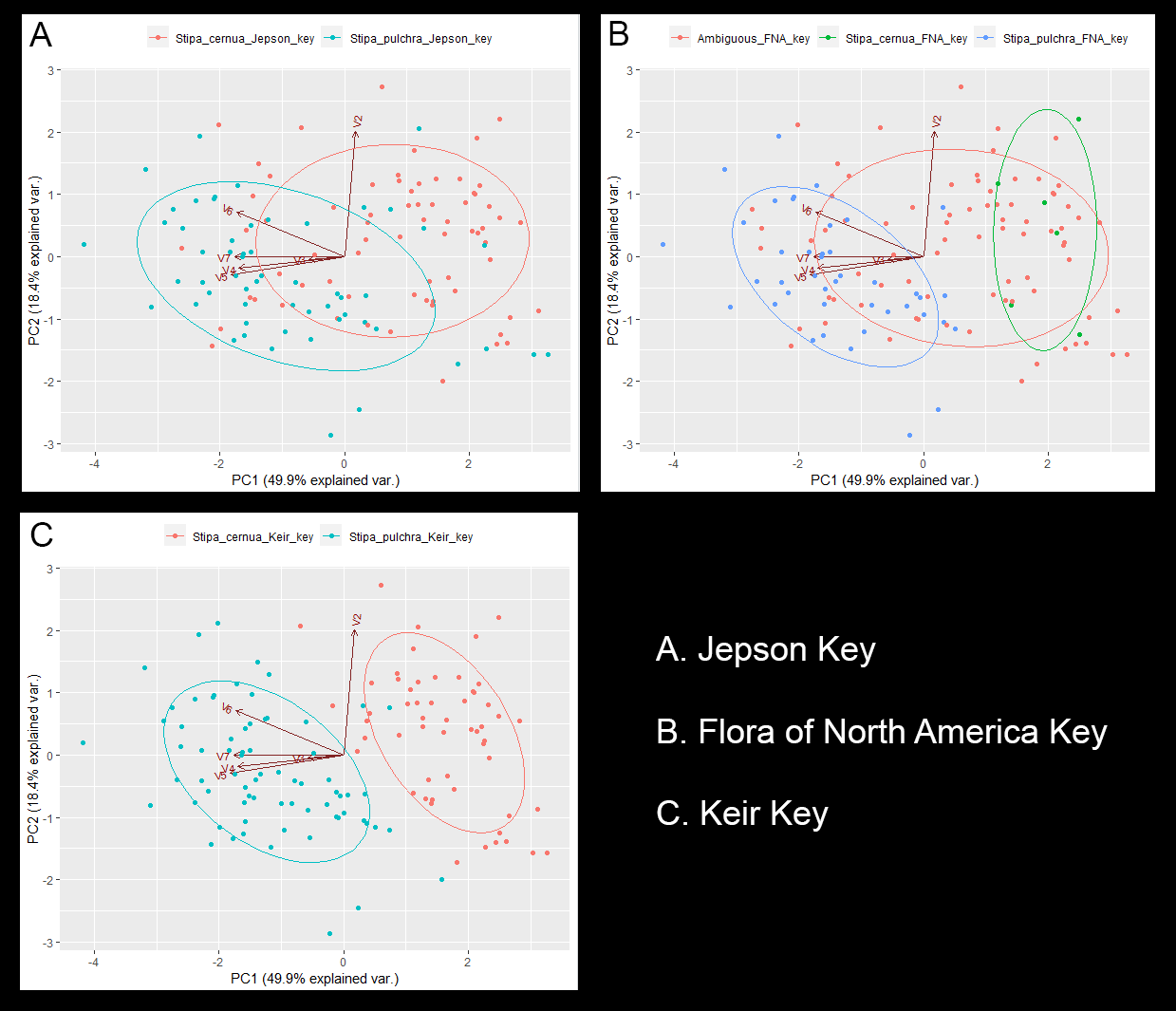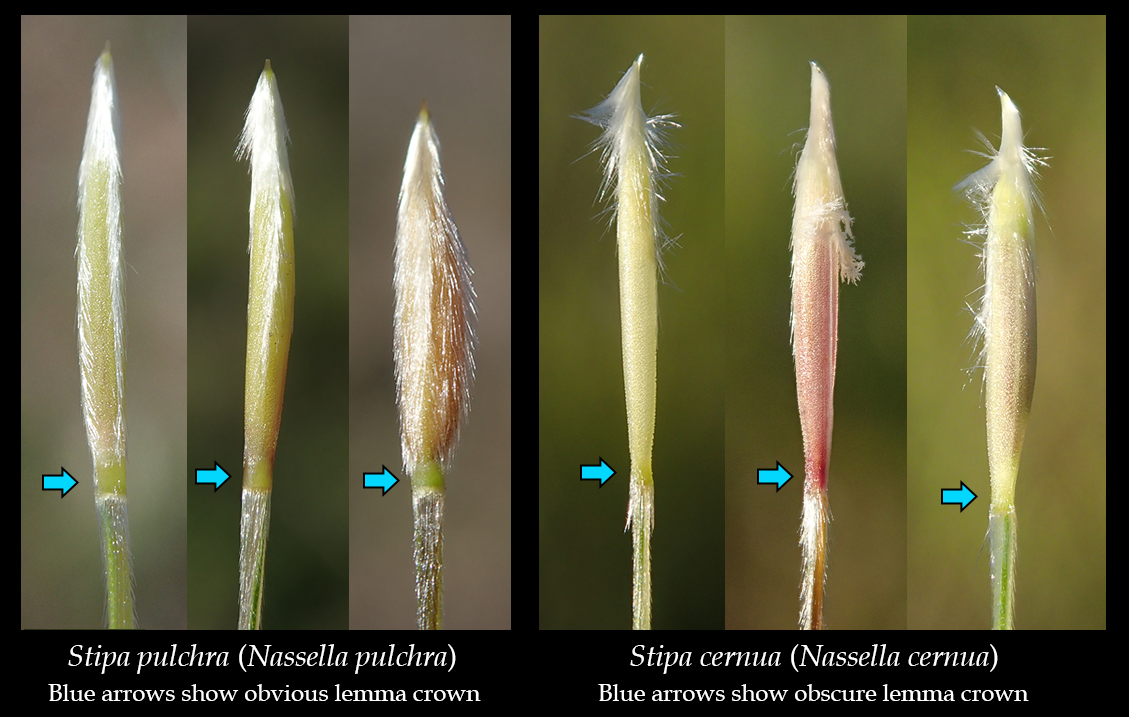How to distinguish Nassella pulchra (Stipa pulchra) from Nassella cernua (Stipa cernua)
Distinguishing Nassella pulchra (Stipa pulchra) from Nassella cernua (Stipa cernua) has confused me for a long time. I decided to look into this late last year to see if I could resolve the issue. Ultimately, the problem comes down to bad keys. Looking through the descriptions of both species, it becomes fairly evident that most measurements overlap between the species and that the most distinct measurement (the lemma crown) is ignored in the keys. So, I looked at hundreds of specimens to see how useful the lemma crown was in distinguishing the two species and it works almost perfectly. I used some fairly simple PCAs to compare using this character to the characters used in the 2012 Jepson Manual key and the Flora of North America key, which showed the other keys to be essentially worthless in distinguishing the two species and at least part of the reason why people confuse the two species. Below are the exact same PCAs with the specimens classified using the 2012 Jepson key (A), the Flora of North America key (B), and my new key (C). The sampling for these PCAs represents the full California range of each species.

In Plot A, you can see the huge amount of overlap between what keys to Nassella pulchra (Stipa pulchra) vs Nassella cernua (Stipa cernua). Sorry for flipflopping between genera but I use Stipa in this figure, so I'll mostly use that in the discussion. The 2012 Jepson keys say "Lemma body in age glabrous in distal 3/4 except on veins" for S. cernua and "Lemma body in age hairy throughout" for S. pulchra. The problem with this is that S. pulchra often has the lemma body in age glabrous in distal 3/4 except on veins. This is even mentioned in the paper that describes S. cernua. So, don't use this character. It doesn't work. If the lemma is super hairy all over, it is probably S. pulchra when faced with just those two species but, if not, it could be either.
Plot B isn't any better. About half of the specimens won't even key using the Flora of North America key and are shown as ambiguous in the plot. Flora of North America says "Terminal segment of the awns cernuous" for S. cernua and "Terminal segment of the awns straight" for S. pulchra. Very few specimens had any awns that were cernuous (nodding / strongly curved). Many specimens of both S. cernua and S, pulchra had sinuous (wavy) awns though, which isn't an option in the key. Many specimens with straight or cernuous awns also had awns that were wavy to one degree or another. If an awn is slightly wavy, it is also questionable as to whether the key author may consider that straight or not. Overall, S. pulchra awns tend to be straighter and thicker whereas S. cernua awns tend to be more wavy and thinner. The extremes are often obvious but there is a lot of overlap between species and a lot of variation even on the same specimen.
Plot C shows two almost distinct clouds of points. This is what you would hope to see in the other plots if those keys actually worked. There is some overlap in Plot C, which is probably mostly due to the fact that I only measured 7 characters. Further sampling of characters would likely increase the distance between the two clusters. The key character I'm using is the lemma crown, which is pointed out in blue arrows in the images below. In Stipa pulchra, the lemma crown is generally very obvious with magnification, though you need to look at the center of the lemma as it may be more obscure near the edges (Compare the first two images in this observation). It is usually fairly glabrous but can be hairier towards the northern end of its range. The lemma crown is generally longer in S. pulchra as well. In Stipa cernua the lemma crown is often pretty obscure and just sort of fades into the rest of the lemma. It may be hairy or glabrous and often is just bumpy. The lemma crown in Stipa cernua is often shorter and you may have to guess at where it actually starts when it is especially obscure. Plants of the Channel Islands can be confusing as many plants of what appears to be S. pulchra there have a fairly distinct lemma crown but it is on the shorter end of the size range and overlaps with the size range of S. cernua. Once you learn what to look for though, if you see an obvious lemma crown using good magnification, it is almost certainly S. pulchra.

If you want to zoom in on some lemma crowns, see the following observations.
Nassella cernua (Stipa cernua):
https://www.inaturalist.org/observations/209184103
https://www.inaturalist.org/observations/43207693
https://www.inaturalist.org/observations/222747745 (Note that this last one is an example where the crown is somewhat distinct and would possibly need to be measured to confirm if you were uncertain.)
Nassella pulchra (Stipa pulchra):
https://www.inaturalist.org/observations/192400698
https://www.inaturalist.org/observations/192400697
https://www.inaturalist.org/observations/109196781
https://www.inaturalist.org/observations/212761073
https://www.inaturalist.org/observations/212303112
Nassella lepida (Stipa lepida)
https://www.inaturalist.org/observations/213733368
https://www.inaturalist.org/observations/212302254
https://www.inaturalist.org/observations/209343249
Writing a revision of the key is not quite this simple as there are a few other Stipa/Nassella involved in the key. Stipa/Nassella lepida is pretty distinct and shouldn't be confused with the others. Stipa/Nassella manicata may be confused with Stipa/Nassella pulchra and is a weed in northern California. There weren't many specimens of that to assess so that part of the key may need work. Either way, below is my draft revision for the part of the Jepson key that has those four species. Give it a try and see what you think.
6a. Lemma crown generally distinct from rest of lemma, crown (0.4)0.5-1.2 mm .....7
6b. Lemma crown transition to rest of lemma somewhat to very obscure, crown 0.1-0.6 mm .....8
7a. Lemma crown ± 1/5 lemma, lemma body in age distally ± glabrous; awns 30-50 mm ..... S. manicata
7b. Lemma crown <= 1/6 lemma, lemma body in age distally ± glabrous or pubescent; awns 38-100 mm .....S. pulchra
8a. Awns 12-55 mm long, 0.1-0.2 mm thick at the base; lemma body in age hairy between veins in distal half ..... S. lepida
8b. Awns 50-110 mm long, 0.2-0.3 mm thick at the base; lemma body in age generally glabrous between veins in distal half (rarely hairy) ..... S. cernua






